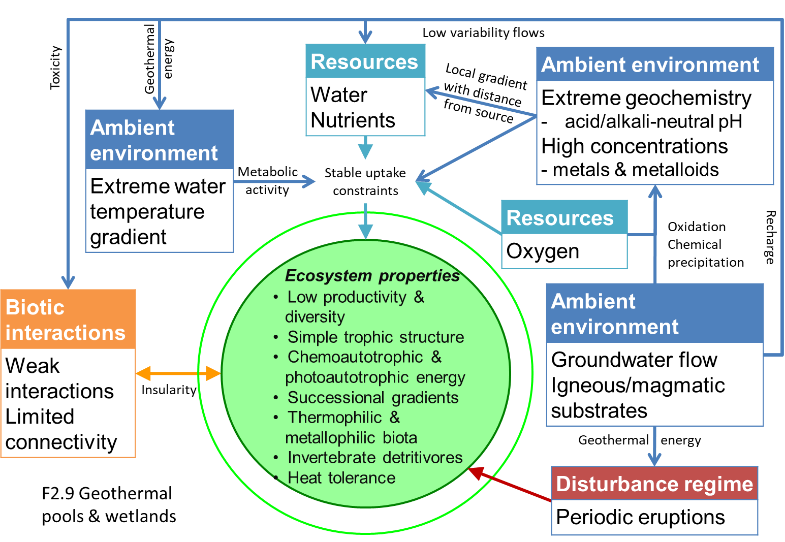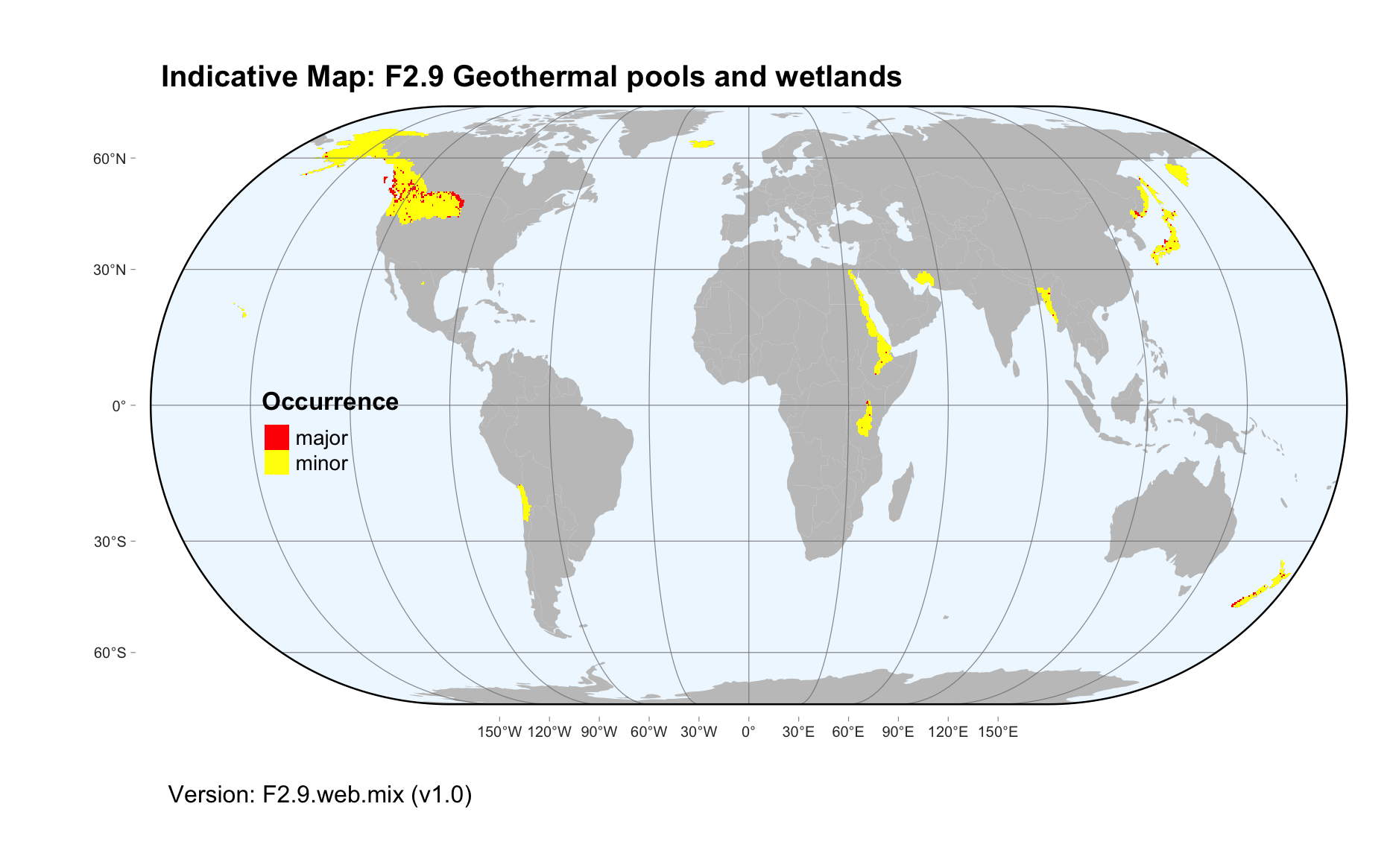Global ecosystem typology
Alternative site for the Global ecosystem typology with additional information for ecosystem profiles and indicative maps.
This site is maintained by jrfep
F2.9 Geothermal pools and wetlands
Biome: F2. Lakes biome
Contributors:
(texts)
Geothermal pools and associated wetlands are fed by deeply circulating groundwater that mixes with magma and hot rocks in volcanically active regions. Mineral concentrations are therefore high and produce chemically precipitated substrates as waters cool. The extreme temperatures and water chemistry limit life to a low diversity of specialised bacteria, extensive algal mats and insect larvae which can live in warm acid or alkaline water with high mineral content. Away from their hottest waters, aquatic plants, crustaceans, frogs, fish, snakes and birds can all occur.
Key Features
Hot springs, geysers and mud pots dependent on groundwater interactions with magma and hot rocks, supporting highly specialised low diversity biota tolerate of high temperatures and high concentrations of inorganic salts.
Overview of distribution
Tectonically or active volcanic areas from the tropical to subpolar latitudes.
Profile versions
- v1.0 (2020-01-20): DA Keith
- v2.0 (2020-05-26): DA Keith; A Channing; PS Giler
- v2.01 ():
- v2.1 (2022-04-06): DA Keith; A Channing; PS Giler Full profile available at official site
Main references
Selected references for this functional group:
Channing A (2018) A review of active hot-spring analogues of Rhynie: environments, habitats and ecosystems Philosophical Transactions of the Royal Society B 373: 20160490
Power JF, Carere CR, Lee CK, Wakerley GLJ, Evans DW, Button M, White D, Climo MD, Hinze AM, Morgan XC, McDonald IR, Cary SC, Stott MB (2018) Microbial biogeography of 925 geothermal springs in New Zealand. Nature Communications 9: 2876. DOI: 10.1038/s41467-018-05020-y
Diagrammatic assembly model

Maps
Maps are indicative of global distribution patterns are not intended to represent fine-scale patterns. The maps show areas of the world containing major (coloured red) or minor occurrences (coloured yellow) of each ecosystem functional group. See general notes on maps.
There are 2 alternative versions of the indicative map for this functional group, please compare description and sources below.
F2.9.IM.mix_v1.0
Datasets
- GSW-1.1
- FEOW-2008
- HydroLAKES-1.0
Map references
Pekel JF, Cottam A, Gorelick N, Belward AS (2016) High-resolution mapping of global surface water and its long-term changes Nature 540, 418-422 DOI:10.1038/nature20584
Abell R, Thieme ML, Revenga C, Bryer M, Kottelat M, Bogutskaya N, Coad B, Mandrak N, Contreras Balderas S, Bussing W, Stiassny MLJ, Skelton P, Allen GR, Unmack P, Naseka A, Ng R, Sindorf N, Robertson J, Armijo E, Higgins JV, Heibel TJ, Wikramanayake E, Olson D, López HL, Reis RE, Lundberg JG, Sabaj Pérez MH, Petry P (2008) Freshwater ecoregions of the world: A new map of biogeographic units for freshwater biodiversity conservation, BioScience 58: 403–414. DOI:10.1641/B580507
Messager, M.L., Lehner, B., Grill, G., Nedeva, I., Schmitt, O. (2016) Estimating the volume and age of water stored in global lakes using a geo-statistical approach Nature Communications 13603 DOI:10.1038/ncomms13603
F2.9.web.mix_v1.0

Datasets
- HydroLAKES-1.0
- FEOW-2008
- GSW-1.1
Map references
Messager, M.L., Lehner, B., Grill, G., Nedeva, I., Schmitt, O. (2016) Estimating the volume and age of water stored in global lakes using a geo-statistical approach Nature Communications 13603 DOI:10.1038/ncomms13603
Abell R, Thieme ML, Revenga C, Bryer M, Kottelat M, Bogutskaya N, Coad B, Mandrak N, Contreras Balderas S, Bussing W, Stiassny MLJ, Skelton P, Allen GR, Unmack P, Naseka A, Ng R, Sindorf N, Robertson J, Armijo E, Higgins JV, Heibel TJ, Wikramanayake E, Olson D, López HL, Reis RE, Lundberg JG, Sabaj Pérez MH, Petry P (2008) Freshwater ecoregions of the world: A new map of biogeographic units for freshwater biodiversity conservation, BioScience 58: 403–414. DOI:10.1641/B580507
Pekel JF, Cottam A, Gorelick N, Belward AS (2016) High-resolution mapping of global surface water and its long-term changes Nature 540, 418-422 DOI:10.1038/nature20584
Check: the Glossary / Profile structure / the public document